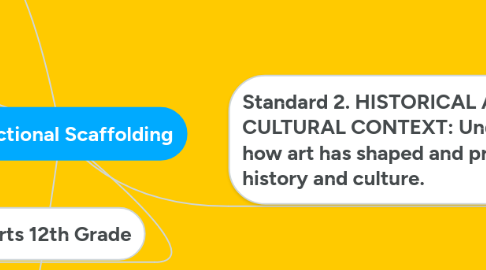
1. Kelsey Smith
2. Visual Arts 12th Grade
3. The very nature of scaffolding relies on methods to break down a larger learning objective into more manageable parts and then ultimately remove the tiers of additional assistance so that the student can continue on as the champion of their own learning process. As applied to reaching this standard the students will go on to create their own visual pieces from each objective. But first they must absorb the massive realm of art history to inform their work. By chunking the research aspects and using scaffold strategies, those scaffolds can then be removed for the student to visually synthesize what they've learned independently.
4. Instructional Scaffolding
5. Standard 2. HISTORICAL AND CULTURAL CONTEXT: Understand how art has shaped and preserved history and culture.
5.1. Learning objectives
5.1.1. DESCRIBE HOW THE ROLE OF ARTISTS HAS CHANGED OVERTIME AND THROUGHOUT SELECTED CULTURES
5.1.1.1. BIG Ideas
5.1.1.1.1. The big idea here is to understand what the roles of artists were in various periods from past to present and be able to describe them. An upward spiral of this information is to contrast how the roles have changed over time. This serves to make useful connections to the context of the cultural and historical climate that caused such change. Ultimately promoting the enduring understanding of how art has both shaped and preserved culture.
5.1.2. CRITICALLY ANALYZE THE CONTENT AND FUNCTION OF SPECIFIC ART OBJECTS, ARTISTS, AND ART MOVEMENTS WITHIN VARIED CULTURES, TIMES AND PLACES
5.1.2.1. BIG Ideas
5.1.2.1.1. Students will build a broader understanding of art history by analyzing various artists, artworks and artistic movements within the context of history. Through critical thinking students will explore the meaning and function of objects and works, the key features of movements, and the motivations and biographies of artists in various cultures as relative to time and place.
5.1.3. DESCRIBE HOW SOCIETIES THROUGHOUT HISTORY HAVE USED IMAGERY TO DEFINE AND PROMOTE POLITICAL, SOCIAL AND CULTURAL AGENDAS
5.1.3.1. BIG Ideas
5.1.3.1.1. By researching and describing purposeful imagery used by various societies to promote an intended agenda students will foster a deeper understanding as to how visual art has shaped and defined history by documenting it creatively.
5.1.4. SYNTHESIZE THE PERSUASIVE POWER IMAGES HAVE IN SHAPING/REINFORCING SOCIETAL OR CULTURAL IDENTITY
5.1.4.1. BIG Ideas
5.1.4.1.1. After historical exploration and analysis of imagery designed to express cultural identity, students will synthesize what they’ve learned about persuasion with powerful images to tell a personal story about their own identity.
5.1.5. EVALUATE HOW COMMERCIAL MEDIA AND IMAGES SHAPE TRADITIONAL AND CONTEMPORARY CULTURES
5.1.5.1. BIG Ideas
5.1.5.1.1. Students will overview the history of medium from the invention of the printing press to present day digital age and evaluate the influence the various commercial medium had/have on shaping cultures.

